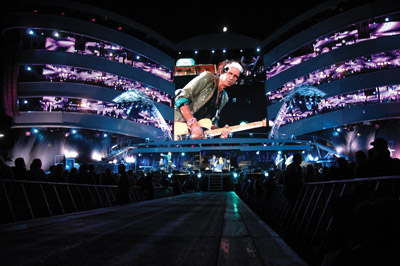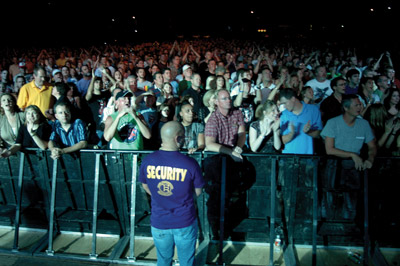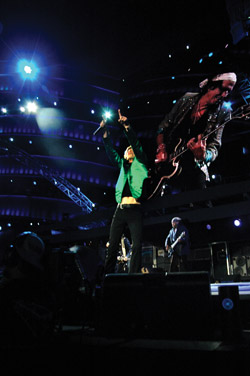
but there's nothing like seeing them in your own back yard," Rudy Rodriguez
’87/87/96, says of the Rolling Stones.
In the 42 years since the Rolling Stones first came to America, the group has released 55 full-length albums, toured the United States 16 times and placed scads of singles in the Top 40.
Though the group has conquered the planet many times over, until quite recently there remained at least one stone left unturned: The Stones had never played in Wichita.
That changed Oct. 1, when Mick Jagger, Keith Richards, Ronnie Wood, Charlie Watts and an extended musical entourage brought their legendary act to WSU’s own Cessna Stadium, where they performed for over 30,000 screaming rock and roll fans — an attendance figure that makes the show the largest concert in the city’s history. “This is our first time here,” said guitarist Richards during his turn as featured singer. “I love firsts! It’s great to finally be here.”
The crowd more than echoed the sentiment, cheering wildly and dancing throughout the Stones’ performance, which ran more than an hour and half. A more diverse audience would be hard to find; entire families attended, from grandparents to preschoolers, most sporting T-shirts emblazoned with the familiar red lips-and-tongue logo the band has used since 1971.
When the Rolling Stones first announced their plan to play Cessna Stadium, locals — including many who work on campus — reacted with a fair amount of skepticism.
The giant facility, though renovated in 1996 and substantially improved in 2002, has been underutilized since the demise of the WSU football program 20 years ago.
Outside of track and field events, which do draw healthy numbers of spectators, the biggest crowd recently assembled at the stadium came in 2001 to see Huey Lewis and the News, booked as part of the Wichita River Festival; they drew less than half the number that came to see the Rolling Stones.
Rock fans can rejoice in the fact that the open-air stadium was just what the Stones were looking for when booking their “A Bigger Bang” tour; the group desired to play more shows on college campuses, and required a sizable outdoor facility to accommodate their massive stage set.

Stadium, an attendance figure that makes the show the
largest concert in the city’s history.
The stage, resembling a building more than a set, loomed nine stories high over the entire south end of the stadium, and housed 220 audio speakers, five video monitors (including one enormous 50-ft-square central screen) and even some 230 seats (at $500 each) for big-spending superfans.
Seventy tractor-trailers were required to haul in the band’s equipment, and 85 stagehands spent the better part of five days assembling the gargantuan stage.
Although there were concerns over traffic and parking — only 10,000 parking spots were available on campus and in available nearby lots — many people carpooled or took advantage of the shuttle bus services offered.
Surprisingly, hundreds of parking spaces remained vacant during the concert, even in lots adjacent to the stadium.
As showtime approached, thousands stood in long, quick-moving lines. Once inside the gates, a variety of concessions were offered — though no alcohol was available.
Staff was on hand to guide attendees to their proper seats; though the potential for unruly conduct certainly existed, the fans proved an orderly bunch.
The California-based rock trio Black Rebel Motorcycle Club (named for the gang in the 1953 Marlon Brando film The Wild One) opened the show, receiving polite applause at the end of each of their songs. But the band seemed resigned to the obvious — the crowd was there to see the Stones.
And after a protracted break between the acts, the crowd got what it wanted, in spades. The blinding white lights of Cessna Stadium went suddenly dark as the video monitors onstage came to life. A short film emulating the Big Bang — complete with classic cars, guitars, lips and shapely feminine legs — burst from the screens, and then, with a barrage of fireworks, the Rolling Stones took the stage.
“I know it’s only rock and roll — but I like it!” came the chorus of their opening song. Afterward, lead singer Mick Jagger, one of rock’s most storied performers, greeted the crowd warmly, as he would continue to do throughout the show. “Thank you so much, Wichita, for making us really feel at home,” he said later in the performance, before strumming his acoustic guitar through one short refrain of the Jimmy Webb-penned classic “Wichita Lineman.”

Prior to the concert, plenty of people had lightheartedly joked about the advanced age of the band (Jagger and Richards are both 63 this year), but few wisecracks were heard afterward; Jagger never stopped moving.
He danced, twirled, shimmied, strutted and wiggled from one set of bleachers to the other, and at one point even sprinted down the long runway in the center of the crowd to a second stage in the middle of the stadium. At one point he even teased the audience, coyly lifting the hem of his T-shirt to reveal his famously lithe abdomen.
The band ran through literally 40 years of material, including selections from every phase of their career.
Among the highlights: “Under My Thumb” (1966), “You Got the Silver” (1969, their first recording with lead vocals by Richards), “Start Me Up” (1981), “Tumbling Dice” (1972), “Sympathy for the Devil” (1968, accompanied here by huge columns of flame from the top of the stage), “You Got Me Rocking” (1994) and two encore numbers, “You Can’t Always Get What You Want” (1969) and, of course, “(I Can’t Get No) Satisfaction” (1965).
At the end of the show, a dazzling display of fireworks shot into the sky to cheers and wild applause. The entire extended band took a bow, then the four men at the nucleus of the group linked arms and took another.
The floodlights came to life and Bob Marley’s “Exodus” (a musical pun, that most English of conventions) began playing over the loudspeakers. The crowd dispersed smoothly into the night, buzzing with excitement.
The Rolling Stones had conquered one more little corner of the world — our corner.





